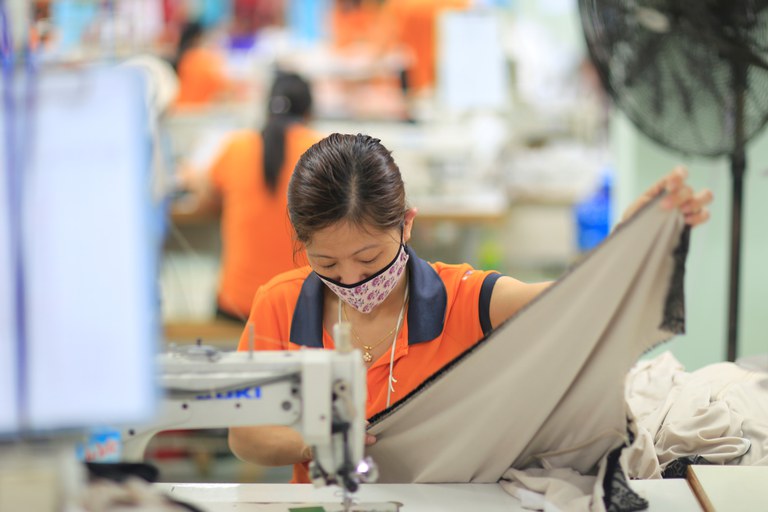“Companies that were responsible during the pandemic recovered very quickly”
The garment sector in Vietnam has experienced remarkable growth over the past two decades, becoming one of the world’s top exporters. How have labour rights and working conditions evolved in this time and what are the biggest remaining challenges?
The garment sector is the second largest sector in Vietnam after electronics. It comprises various tiers. The so-called second largest exporters are larger factories that have very good financial resources and talk directly to the brands. According to VITAS (Vietnam Textile and Apparel Association), there are about 500 to 1,000 companies in Vietnam that do business directly with international buyers.
The industry has experienced an economic setback in 2020 due to the pandemic, but last year the export value of textiles and garments in Vietnam was about US$39 billion, which is a remarkable recovery despite all the difficulties. The size of the industry in Vietnam has doubled since the 1960s, and there have been significant improvements in core labour standards, particularly child labour and forced labour. Comparing the 2010 and 2020 compliance reports from the ILO Better Work programme proves this. The only area where Better Work has not seen much improvement is in working hours. Ten years ago, about 85% of Better Work companies were not complying with legal working hours; last year, it was 78% - a decline, but still low compared to other areas of labour standards. Nevertheless, it is becoming noticeable that labour rights have improved significantly over the past decades. That's the situation for bigger companies.
And what is the situation of smaller enterprises and subcontractors in the Second Tier?
While fewer than 1,000 factories are directly exporting, the garment industry as a whole comprises about 11,000 manufacturers. Lower tiers consist mainly of micro-enterprises and those operating in private households. In these enterprises, there are very few audits of labour standards, and according to my research, when we investigated labour standards in 2015/2016, we found that there are a lot of problems with working hours and many violations of labour contracts. Workers have been working in a factory for 5 or 10 years but still have the same 3-month contract, which is against the law. There have been cases of factory owners absconding overnight, leaving thousands of workers without social security because they first collected the money but did not pay it to social security. In these cases, workers have no way to raise their voices, complain, or even get information about what is going on at the company. Such incidents occurred frequently during the pandemic, too.
There is also the issue of occupational health and safety. Small companies often feel they lack financial resources to ensure there are fire safety measures in place or that working conditions meet supply chain standards. I don't see much improvement in terms of labour laws and working conditions in this Second-Tier group.
Are there any actions taken by the government to address these labour rights violations?
For the last 10 years, we have been trying to draw attention to this issue. The problem of labour inspection in Vietnam, just like in other developing countries, is that we lack resources, inspectors, and an up-to-date approach to labour inspection. For these reasons, monitoring of Second Tier manufacturers has not been so successful in Vietnam.
And what about the responsibility of the brands?
Brands usually try to monitor the First Tier suppliers directly. The First Tier, in turn, signs an agreement with the brand that it is responsible for upholding labour rights among subcontractors. However, this is where many problems arise. We have often come across the First Tier supplier not informing the brand of who it is subcontracting to, simply hiding downstream labour rights violations, or choosing subcontractors that offer the lowest price. Low costs often go hand in hand with labour rights violations, so this is an issue that we raise with brands, but with limited response so far.
Let's talk about the impact of the Covid-19 pandemic. How successful has government support for workers and factories been during the pandemic?
The support in Vietnam has started with the first package to help factories and workers in May/June 2020. So far there have been three packages and the fourth will start soon. However, the support packages are very small. The pandemic has affected the lives of millions of workers. In the garment industry alone, it's at least 4 million workers and thousands of businesses. If you look at the support packages, it's in the size of roughly 7.9% of Vietnam's GDP, but if you compare this to the average of other ASEAN countries, according to an ILO study, the size of support packages is roughly 15,8% of GDP. Hence ,we see that the support package offered by the Vietnamese government is only half the size of other ASEAN countries - that is small.
Speaking of other sources of support, has the industry received support from brands that are sourcing in Vietnam?
We conducted a survey last September among brands sourcing in Vietnam and identified the type of support they provided to manufacturers. Almost 70% of buyers said they accept that suppliers deliver late - a good result. But only 29% said they would not lower prices for orders already signed. So, it was common that the surveyed suppliers were confronted with requests from buyers that they should lower prices by about 10-15% because of the delay. Only 16% of the buyers said they share air freight costs with suppliers. Due to delivery delays, manufacturers have started shipping by air, which is very expensive. Brands often shift the burden to manufacturers. We found that over 60% of garment manufacturers in our September 2021 survey had to cover the cost of air freight on at least one of their next orders.
With Covid-19 still looming large, labour shortages are now becoming a critical challenge in the sector. What is the current situation at factory level, and how is this situation affecting production and wages in the industry?
Reports of thousands of workers leaving the industry are overstated. If you look at the garment industry in Vietnam last year, it is divided into two parts. The Southern provinces have suffered a lot from the pandemic, and many workers from the South have returned to the North. Our surveys from last year show that factories in the North and Centre of Vietnam are hiring more and more workers from the South. Since these are often very skilled workers, this is fortunate for the factory owners.
Is there a solution for the factories that face labour shortages?
The solutions mainly concern factories in the South, not factories in Central and North Vietnam. This is because the labour shortage is much more severe in the South. At the same time, companies in the South are intentionally keeping their capacity low, about 75-80% according to our research, because they are not sure how many workers are available and how many people have contracted Covid-19. In addition, the local government is trying to provide low-cost housing to retain migrant workers. Several housing projects are currently being developed in South Vietnam to keep migrant workers. However, many of the garment companies I spoke with in the South are quite indifferent to the labour shortage, as they have their factories all over the country. For example, in Hanoi or in Bac Ninh - if they have to reduce their capacity in the South, they simply increase it in the North.
How important is social sustainability to Vietnamese garment producers and did they uphold their responsibilities to workers during the pandemic?
Even before the pandemic, a lot of attention was paid to sustainability. But over the course of the pandemic, that changed: It's very interesting that when we had the first Covid-19 cases and there were disruptions in the supply chain with China, the first reaction of companies was to cut labour. Many companies immediately laid off hundreds of workers and problems resulted from this. Workers were put under pressure to sign letters of resignation. This led to the workers becoming angry and not wanting to return to the factory. During the four-month closure of a factory near Ho Chi Minh City, many workers told me they had tried to call the HR department but had not reached anyone. These workers no longer had any income, could not buy anything to eat. One of the women who told me this returned to the North. She had worked for this company for ten years and received no support during this difficult time.
But there are other examples. Many garment companies I work with, larger and smaller, have become very responsible. The minimum wage continued to be paid to workers beyond the legally agreed-upon date. I've witnessed cases where even workers who were in quarantine and didn't have a bank account received their salary in cash so they could provide for their children. The companies that were responsible during the pandemic recovered very quickly. This is an important lesson for garment factory owners and for everyone involved in the garment industry, including buyers. When I talked to the buyers, they said that all the suppliers who behaved responsibly towards their workers during the pandemic recovered faster.
What are the three areas the industry needs to prioritize to ensure continued growth and sustainability in the long run?
The first area is supply chain diversification. The industry has been too dependent on suppliers from China. If the supply from China is interrupted it will have a serious impact on the garment industry in Vietnam. Therefore, in the last two years, garment manufacturers have tried to diversify their sources of supply, with some success. They source the material from Vietnam or from South Korea, for example.
The second area is digitalization, which is critical if you want to keep your place in the global supply chain -whether it's improving efficiency from materials to shipping to retail and, of course, in terms of social and environmental transparency. Brands are asking their suppliers to digitalize the whole process, and if the EU adopts due diligence laws, there will be yet more pressure on factories to digitalize. Lastly is that we need to improve the reputation of products made in Vietnam. Vietnam has made many attempts in the last decade or two to become a global centre for the garment industry. Yet most manufacturers have failed to earn a reputation for (good) social and environmental standards. When I spoke to 200 apparel manufacturers about this issue at a VITAS conference in 2020, I received a lot of encouragement from the attendees. But there is still a lot of room for improvement here.

About Dr. Do Quynh Chi
Dr. Do Quynh Chi is the Director of the Research Center for Employment Relations (ERC) in Hanoi. She has been a labor researcher, trainer and consultant for over 19 years. Most of her experience has been in the manufacturing industry. With her international experience and in-depth national knowledge, she focuses on research, training and consulting that are practical and benefit workers.

